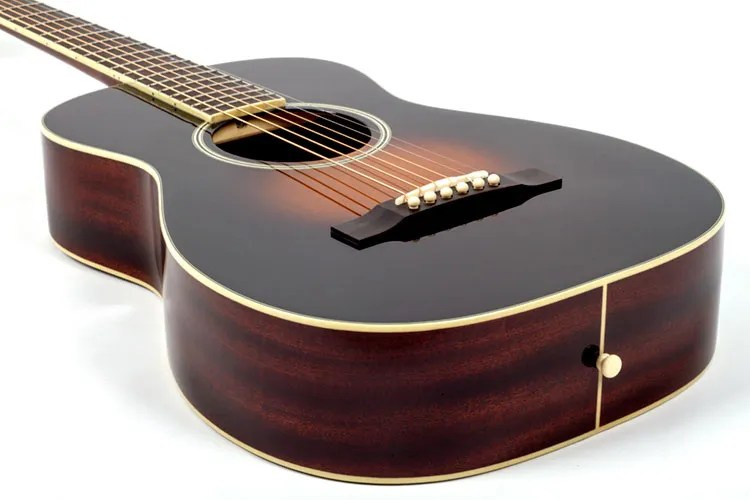For decades, the acoustic guitar landscape was dominated by the booming voices of dreadnoughts and jumbos. These larger-bodied guitars are celebrated for their rich bass and powerful volume, but their size can be a significant drawback for some players. The rise in popularity of smaller-bodied instruments, particularly parlor guitars, addresses this issue, offering comfort and portability without sacrificing musicality. While it’s true that smaller guitars may not possess the sheer volume of their larger counterparts, the current market offers a wealth of choices, allowing players to be selective and find compact instruments with remarkable tone. The Gretsch G9511 Single-0 Parlor guitar is a prime example of this new breed, delivering a refined sound and an enjoyable playing experience in a smaller package.
The Gretsch G9511, crafted in Indonesia, showcases impressive build quality for its price point. It’s finished in an “Appalachia Cloudburst” that lends a warm, smoky aesthetic to the solid Sitka spruce top. A thin gloss finish over the top and the laminated mahogany back and sides provides a subtle sheen, enhancing its visual appeal. The mahogany neck features a matte finish, a feature many guitarists, including myself, find preferable for its smooth, comfortable feel. Vintage-style butter-bean open-geared tuners contribute to the guitar’s classic vibe, while the bone nut and saddle add a touch of class and contribute to its overall resonance. The fretwork is clean, with no sharp edges, and the guitar is set up for comfortable playing right out of the box, boasting low action and no fret buzz. Aside from a minor instance of overspray near the soundhole, the fit and finish are remarkably clean for a guitar in this price range.
My experience reviewing the G9511 revealed that it truly shines with a lighter touch. While I typically employ a flatpick or thumbpick for most playing styles, I found myself gravitating towards fingerstyle playing with bare fingers on this guitar. A gentle approach coaxes a sweet and nuanced tone from the instrument, appealing to a more mellow, jazz-influenced sensibility. Though jazz isn’t my primary genre, the lush sounds of major 7th and 13th chords resonated beautifully on the Gretsch, highlighting its tonal complexity.
Blues fingerpicking is my core style, so I switched to a thumbpick to explore John Hurt’s “Stagolee.” The Gretsch surprised me with a sound that was fuller than anticipated for its size, exhibiting a pleasing balance between bass and treble frequencies. Next, I experimented with dropped tunings, lowering the 6th string to D and playing William Moore’s “Old Country Rock.” A common concern with small-bodied guitars, especially those with light gauge strings (.012–.053), low action, and a shorter scale length (24.875 inches), is their performance in lower tunings. However, the G9511 once again exceeded expectations, maintaining a clear and defined tone even in drop-D. The low D string retained a degree of articulation and avoided sounding muddy or indistinct.
Encouraged by these results, I tuned further down to open D (D A D F# A D) and played through “Vestapol.” The Gretsch continued to impress, handling the lower tuning with surprising poise. The sound possessed a captivatingly intimate quality, characterized by warm, present mids and clear, articulate trebles that avoided harshness or excessive brightness.
The matte finish on the neck proved to be exceptionally comfortable and easy to navigate. The 1.73-inch nut width and 2-3/8-inch string spacing at the bridge provided ample room for both flatpicking and fingerstyle techniques. Gretsch describes the neck profile as a slim “C” shape, which felt comfortable and familiar in hand. Returning to standard tuning, I tested the guitar’s flatpicking capabilities with The Beatles’ “I Feel Fine.” The G9511 produced a crisp, almost electric guitar-like tone, with single-note lines projecting clearly. The primary limitation I encountered with the Gretsch was in its capacity for robust strumming. Big, open G chords lacked the warmth and inviting resonance typically associated with larger guitars. The harder I strummed, the more the tone tended towards harshness. It’s also worth noting that the neck joins the body at the 12th fret, which might restrict access to the higher frets for some players.
In today’s market, players seeking a small-bodied acoustic guitar are presented with numerous options. However, at a street price of $299, it’s unlikely you’ll find many instruments that rival the Gretsch G9511’s blend of tonal complexity and playability. This Parlor Acoustic Guitar offers a compelling value proposition for players seeking vintage-inspired charm and a comfortable playing experience.
 Gretsch G9511 Parlor Acoustic Guitar in Appalachia Cloudburst finish showcasing solid Sitka spruce top and vintage-style tuners
Gretsch G9511 Parlor Acoustic Guitar in Appalachia Cloudburst finish showcasing solid Sitka spruce top and vintage-style tuners
Gretsch G9511 Style 1 Single-0 Specifications:
Body: Parlor-sized body with X-braced solid-spruce top and laminated mahogany back and sides; aged white binding; rosewood bridge with bone saddle; Appalachia cloudburst gloss urethane finish
Neck: 24.875″-scale mahogany neck with slim-C shape, 19-fret rosewood fingerboard with 12.6″ radius, 1.73″-wide bone nut, vintage-style open geared tuners, matte finish
Other: D’Addario EXP16–coated phosphor bronze, light gauge (.012-.053); optional gig bag or hardshell case
Price: $499 list/$299 street
Made in Indonesia gretschguitars.com
This review is adapted from an article originally published in the November 2017 issue of Acoustic Guitar magazine.
